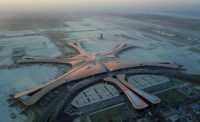Ten thousand people who lived in a rural village on the site were quickly displaced, and the settlement bulldozed. Foster, who previously didn’t have a presence in Beijing, established an office in 10 days. At the peak of construction, 50,000 workers buzzed on-site, erecting the terminal with mostly local materials. And four years later, the glittering project debuted on schedule. (By comparison, London Heathrow’s T5 took 20 years from design to completion.) The result is not only the world’s biggest airport building, but one of the best. Terminal 3, intuitive and efficient to use, reimagines circulation for passengers and vehicles alike.
Twice as large as the Foster-and-Arup-designed Chep Lap Kok airport in Hong Kong, Terminal 3 measures almost 14 million square feet and cost $3.65 billion to build. It comprises three buildings, aligned on a 2-mile-long, north-south axis, that form an elongated hourglass shape in plan. Travelers arrive at the south end of the building, where they get a sense of the terminal’s great scale: a soaring roof canopy rises to 148 feet above ground and tapers at the sides to 49 feet. Columns at the center of the canopy are painted red, while outlying ones fade to orange then yellow—all part of a sophisticated color scheme that plays on traditional Chinese themes without falling into cliché or stereotype.
The northern terminus, whose shape mirrors that of the entry building, holds international gates, while a narrow finger building with additional gates to accommodate Olympiad travel and future growth connects the two. Two runways, one not yet constructed, sandwich the three volumes, and a pair of taxiways cut through the central link. Just south of the entry, an oval-shaped transit station connects passengers to a downtown subway and bus hub in 15 minutes.
Despite all the activity under one giant roof, Foster and Arup designed the terminal in a way that “takes the anxiety out of” airport travel, says Majidi. The central-axis plan, which directs passengers from check-in to domestic and then international gates, minimizes the flangelike concourses of other airport terminals, while interior details such as unidirectional ceiling slats point travelers in the direction of where to go next.





